September 2019 Independent Eating and Drinking Newsletter
| Independent Eating and Drinking are Wonderful |
 |
| September Newsletter Topics: |
|
| Subscribe to Newsletters |
According to the National Institute of Neurological Disorders and Stroke: “A tremor is an unintentional, rhythmic muscle movement involving to-and-fro movements (oscillations) of one or more parts of the body. It is the most common of all involuntary movements and can affect the hands, arms, head, face, voice, trunk, and legs. Most tremors occur in the hands. In some people, tremor is a symptom of a neurological disorder or appears as a side effect of certain drugs. The most common form of tremor, however, occurs in otherwise largely healthy people. Although tremor is not life-threatening, it can be embarrassing to some people and make it harder to perform daily tasks”.
When discussing tremors it is easy to be confused by the cause of the tremor, which might be a disease or disorder, and the types of tremors caused by the disease or disorder, such as a resting tremor, or a task specific tremor. The first section of this article discusses causes of tremors and is followed by information about types of tremors. It should be noted that Essential Tremor is the name of a neurological disorder not a type of tremor.
The most common causes of tremors are:
Essential Tremor (ET) that affects about 10 million people in the United States. ET is a progressive neurological disorder that causes involuntary rhythmic trembling of the hands, head (including the tongue and voice), and less often, the trunk or legs. A miscommunication between parts of the brain causes the disorder.
Parkinson’s disease, that impacts approximately one million Americans, with 60,000 people being diagnosed with the disease each year. Parkinson’s disease is caused by damage to the portions of the brain that control movement. Initially a tremor may occur in a single limb but will progress to a bilateral tremor and, over time, tremors can affect the head, trunk, arms and legs. Tremors markedly increase with stress. A continuous “pill-rolling” motion of the thumb and forefinger is common with Parkinson’s disease.
Dystonia (for which the incidence is not known). Dystonia is caused by abnormal functioning of the basal ganglia (the part of the brain that controls coordination of movement) and causes uncontrollable twisting, repetitive movements, or abnormal posture and positioning.
Multiple Sclerosis (MS), which affects 2.1 million people worldwide, is a disease in which the body's immune system eats away at the protective sheath (myelin) that covers the nerves. Damage to myelin causes interference in the communication between the brain, spinal cord and other areas of the body.
Other causes of tremors include stoke, and traumatic brain injury.
Tremors can also be categorized by type:
Resting tremor occurs when the individual is relaxing or resting and is often seen in the hands and fingers. Resting tremor is seen in individuals with Parkinson’s disease.
Action tremor occurs when the affected body part is moved. Sub-categories of action tremors are: Postural tremor that occurs when a person tries to hold a position which pushes against gravity, e.g., holding their arms out in front of their body; Kinetic tremor which occurs when the body part that is affected is intentionally moved, e.g., raising and lowering the hand at the wrist; and Intention tremor which occurs when an affected body part is moved towards a specific object, e.g., bringing your index finger to touch your nose.
Task specific tremors, as the name implies, occur when a specific task is undertaken, e.g., signing your name.
Isometric tremor occurs when the muscle of an affected limb is voluntarily contracted and the limb is opposed by a rigid object, e.g., placing your hands on a table surface and pressing down or leaning on your hands.
Depending upon the cause of the tremor, they can impact hands, arms, head and neck, the tongue and voice, legs, and trunk. If the head and neck muscles are affected, chewing and swallowing can become difficult. Regardless of the cause of tremors they can make independently conducting activities of daily living extremely difficult. Additionally, many people who have tremors are embarrassed by them and they can cause a great deal of frustration when it is difficult to coordinate and control ones movements. Treatments are available for some diseases that cause tremors. If you start noticing some tremors, consult your physician for more information about treating them.
Tremors that impact the hands, fingers, arms, and head make conducting regular activities especially difficult. For example when attempting to brush your teeth it is difficult to maintain the tooth brush on the teeth in the mouth when both your head and hands are in almost constant motion. The likely result is that toothpaste will go all over the place during the process. To lessen some of the movement, the elbow can be braced on either the bathroom counter or against a wall close to the sink, and the heel of the hand holding the toothbrush held firmly against the chin. This provides some stability during the process. It is also highly recommended to use an electric toothbrush to lessen the amount of movement needed during the brushing process.
Eating can present similar problems of stabilizing the hand and arm. Feeding yourself can be extremely difficult, especially when dealing with intention tremor, which worsens when the hand is brought towards the mouth (commonly seen in Essential Tremor), because each time the hand is brought to the mouth the tremor becomes exaggerated.
Finding ways of making eating easier requires experimentation as each person is different and, therefore, trial and error is the only way of finding the best method. Things that may be of help are:
1. Always sitting at a table to eat. Make sure that the elbow of the hand holding the utensil rests on the table. This may require putting a board (or book, or something equivalent) on the table to raise the level of the elbow for the utensil to reach the mouth while the elbow is still on the table. Alternately, if the table is too high, a cushion should be added to the chair to raise the level of the trunk. Always make sure that the feet can still rest firmly on the floor to provide stability.
2. Consider wearing a weighted cuff on the wrist of the hand holding the utensil. Weights can be purchased from medical catalogs and online. However, it is wise to try using one before buying one to find out if it is of value. An easy way to experiment with a weighted cuff is to take a pair of tube socks and put one inside the other. Fill the socks with a pound of dried beans or rice. Sew the end shut and then sew a strip of Velcro on each end of the sock to hold them in a circle. The socks can then be wrapped around the wrist. If the one pound weight appears to be of help in dampening the tremor but is not sufficient to stop food being shaken off of the utensil, the sock should be reopened and another pound of beans or rice added. If two pounds do not help with dampening, the weighted cuff will not be of value.
3. Build up the handle of your eating utensils. It is easier to grip a larger handle on a utensil and hold it firmly. Utensils with built up handles can be purchased at many different locations. Simply search online for “utensils with built up handles” and a list of sources will be displayed. For a quick test, use duct tape or masking tape to build up a handle, etc.
4. If maintaining a grip on a utensil is difficult, an Eating Cuff may be helpful (not to be confused with the weighted cuff mentioned earlier in this article). There are a variety of cuffs that are commercially available. Google “eating cuffs” to see the range of products that can be chosen from.
If all of these strategies fail to help maintain the ability to eat without food falling off of the utensil due to tremor, more advanced assistive technology (AT) should be considered. AT that facilitates independent eating can be broken down into two discrete categories: manual and powered. Manual feeding devices are moved and manipulated by the individual who is eating. The general principal of manual feeding devices is that they stabilize the hand and arm, thus dampening involuntary movement. They work by either “trapping” the arm in a trough that limits the range of motion that is possible for the hand and arm, or, the hand grasps an arm to which the spoon is attached. The arm is either weighted or spring loaded. In either case, the arm movement is dampened, eliminating much of the involuntary movement of the hand.
Powered feeding devices move without any energy being contributed by the user to pick up food. They are electro-mechanical devices and the spoon picks up food and presents it close to the user’s mouth for them to eat. Spoon activation is typically initiated by the use of an adaptive switch that requires an extremely small movement (or force) by the user to trigger it. Powered dining equipment like the Mealtime Partner, allow the user to sit in an appropriate position to facilitate safe eating. While eating, the user can rest their hands in their lap or on a table top, depending upon the type of tremor that they are dealing with. Even those who have a tremor affecting their head will have less involuntary movement when they eat using an assistive dining device as they must only make a small movement of the head towards the spoon, and their hands remain inactive during this time. When taking a bite of food, intention tremors and task specific tremors create less forceful head movement when the hands are not moving at the same time. The Mealtime Partner Assistive Dining Device is the only powered dining system available in the United States that can be adjusted to meet the specific needs of individuals who have tremors. It can be customized to the appropriate speeds and pauses to allow the user to have a stress free meal and avoid triggering tremors. Click on the following link for more information about the Mealtime Partner Dining System.
Tremors also make it difficult for people to lift and hold a cup. Proper hydration is essential to maintain good health and therefore should be addressed once a tremor is diagnosed. The issue of access to liquids should be revisited as tremors worsen. Mealtime Partners offers several options for hands free drinking.
| A Hands-Free Drinking System to Meet Everyone's Needs | |
A hands-free drinking system can enable everyone with the ability to create suction, to drink independently throughout the day. Mealtime Partners, Inc. has several different types of hands-free drinking systems to choose from: the Hydration Backpack with Drinking Tube Positioning; the Front Mounted Drinking System; and the Drink-Partner. They can all be easily attached to a bed or wheelchair and can be positioned to meet the individual user’s need. |
|
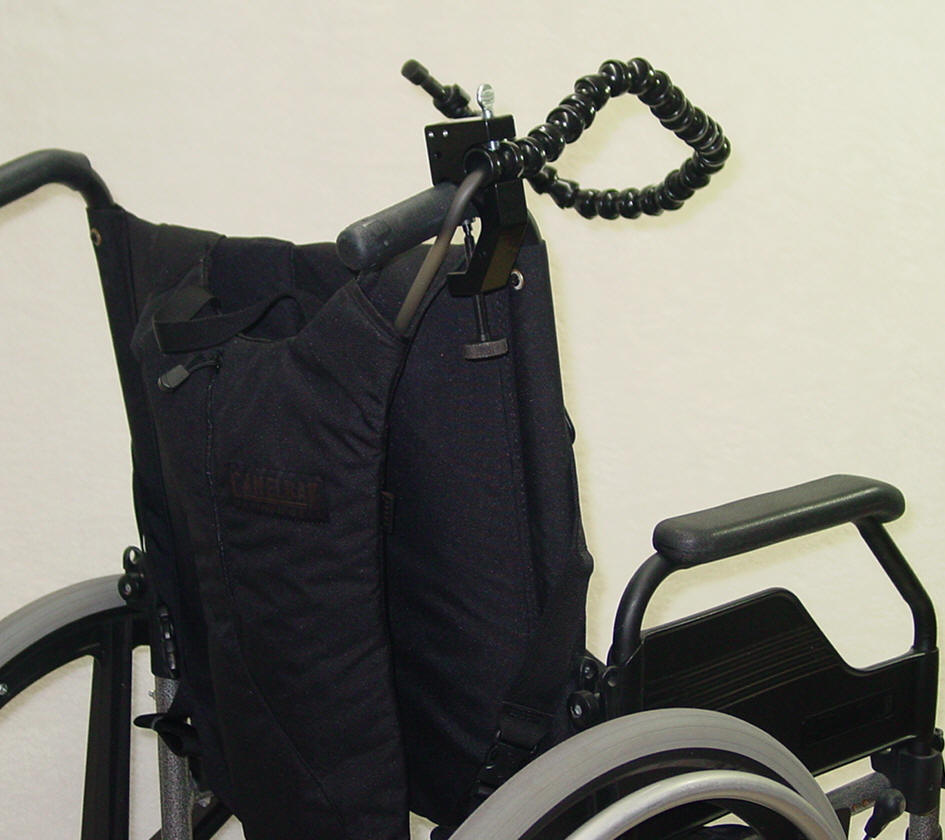 |
|
| Hydration Backpack with Drinking Tube Positioning (i.e., for Manual Wheelchairs) | Hydration Backpack with Drink Tube Positioning for Slide Track |
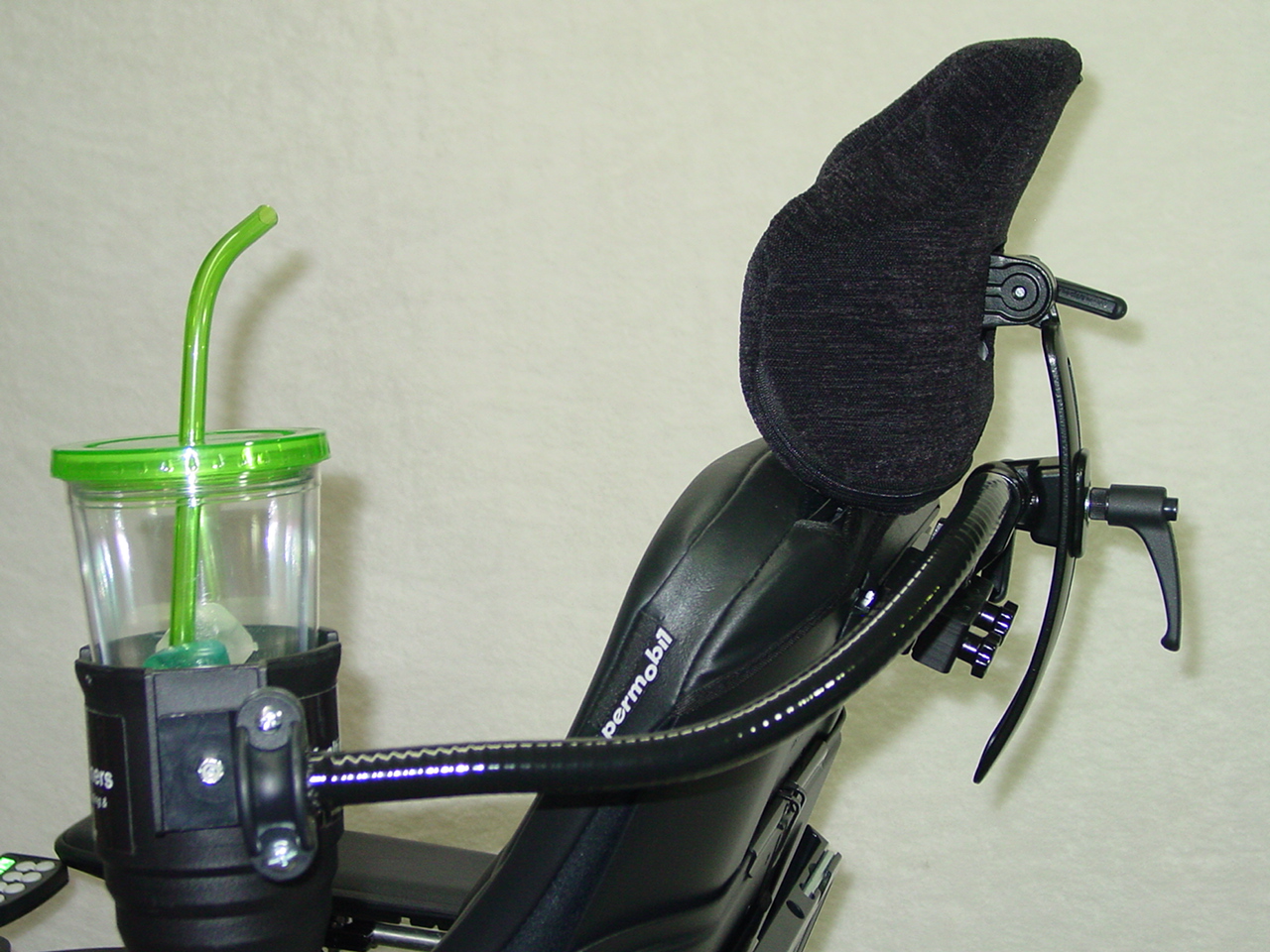 |
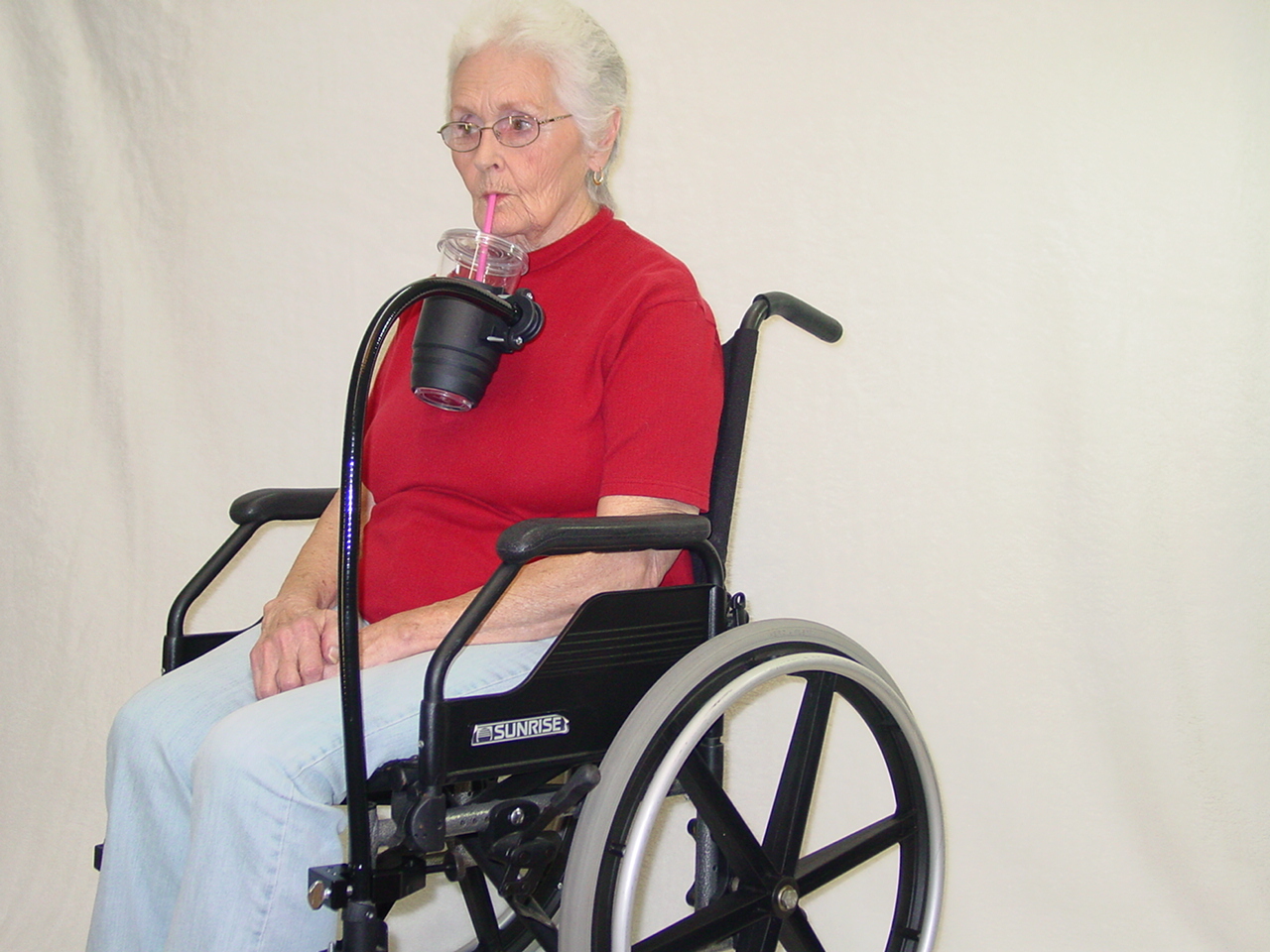 |
| Front Mounted Drinking System for Wheelchairs with Slide Track | Front Mounted Drinking System for Manual Wheelchairs |
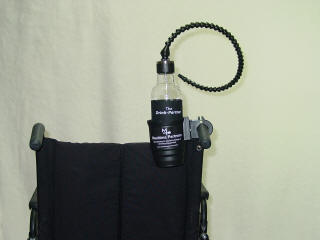 |
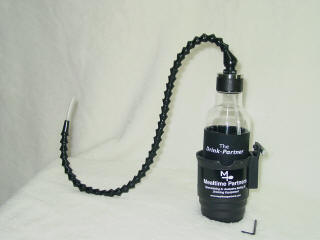 |
| Drink-Partner Mounted on a Wheelchair Handle | Drink-Partner for Slide-Track |
| To view all of the Mealtime Partners drinking products, click here. Remember Mealtime Partners drinking products can be attached to powered wheelchairs with slide-tracks, manual wheelchairs with handles and/or tubular frames, or hospital beds with plastic or metal bed rails. For additional guidance about how to select the appropriate drinking system for your specific needs, click here. | |
The Mealtime Partner Cup Holder
The second article in the May 2019 Newsletter discussed the Front Mounted Drinking System. One of the components used in this drinking system is the Cup Holder and it was described in the article. The cup holder is used in all Front Mounted Drinking Systems and all Drink Partner Drinking Systems and therefore is a significant component of many of our drinking systems. However, in the May 2019 article and, as a matter of fact, all other articles about drinking systems, and, anywhere else on our website, the specific dimensions of the cup holder are not provided. This oversight will be corrected here.
 |
| Cup Holder Dimensions |
It should be noted that the rectangle that is shown on the right side of the illustration is where the various mounting systems that hold the cup holder in place are attached. The type of mount depends upon what wheelchair or bed it is being attached to.
The Front Mounted Drinking Systems are sold with a foam koozie included in the package. The Koozie fits snuggly into the cup holder and can hold a 12-oz can or bottle. When the Koozie is inserted into the Cup Holder, it will need to be pressed firmly into it to “seat” it all the way into the holder.
.
|
Did you know? Did you know that it has been shown to be unnecessary to take the 600 IU (international units) of vitamin D that is the current recommended daily dose? Results of a 3-year study of over 300 people aged 55 to 70 shows that taking more than 400 IU of vitamin D per day led to a greater reduction in bone mineral density than if you only take 400 IU. Participants either took 400, 4,000, or 10,000 IU of vitamin D per day. Bone strength and density, vitamin D, and calcium levels, were measured throughout the study. Results showed a greater loss of bone mineral density in participants who took the larger doses of vitamin D. In all cases there was a small reduction in bone mineral density, however, researchers attribute this loss to the natural aging process. The loss was greater in those who took the higher doses of vitamin D. The study is reported in the Journal of the American Medical Association (JAMA) 2019 titled Effect of High-Dose Vitamin D Supplementation on Volumetric Bone Density and Bone Strength |